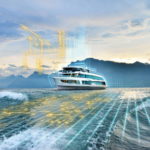Emissions by vessels of all sizes and uses powered by heavy fuel oil contribute to air pollution and fire discussions not only in port cities. To reduce exhaust gases harmful to human health and world climate, environmentalists and politicians have taken up the cause. As of 2020, the International Maritime Organization (IMO) has stipulated more demanding emission levels which preclude the use of this cheap but especially polluting bunker fuel
By now, long-term technical alternatives are available that could already significantly improve the exhaust gas situation in ports today[ds_preview]. In Hamburg, for example, the latest HADAG ferry »MS Elbphilharmonie« is equipped with a diesel-electric drive which turns the first ship of the new »Type 2020« series into an energy-efficient, low-emission and quiet vessel. This system delivered by Siemens for the electric part provides only as much energy as needed for each drive mode.
For over 10 years, the electric company has been working on environmentally friendly alternatives in shipping. The diesel-electric drive was constantly further developed during this time and has been installed aboard numerous, very different ships. »MS Diamant« of the shipping company of Lake Lucerne (SGV) also utilizes this technology. This vessel accomodates up to 1,000 passengers while the propulsion is based on the innovative parallel hybrid drive concept »SISHIP EcoProp«. This design is defined by two permanently excited synchronous electric motors by Siemens, each with an output of 180kW, operated as generators. Two additional diesel generator sets in the bow of the ship ensure the supply of the electrical system at high loads, e.g. at banquets on board. Thanks to the hybrid drive, the machines always run in the optimum range, thus saving up to 25% fuel during operation.
The world’s largest hybrid-powered ferries also range among technology pioneers where a combination of diesel engines, electric motors and additional battery storage defines the drive concept. »Berlin« and her sister ship »Copenhagen« commute on the Baltic Sea between Rostock-Warnemünde, Germany and Gedser, Denmark. The Puttgarden-Rødby ferry service is also operated by several vessels which have been retrofitted with hybrid drive systems. These engines save at least 15% of carbon dioxide emissions.
First electric car ferry carries up to 120 vehicles
Hybrid drives are an ideal option for inland navigation as well as offshore. Siemens has already supplied such systems to a variety of ship types, including vessels used for offshore tasks. Meanwhile, the pure electrical mode for ships has been realized which is easily implemented on ferries with defined route lengths. Since 2015 car ferry »Ampere«, which travels the Norwegian Sognefjord silently and without emissions, gives proof of this. The world›s first all-electric ferry departs 34 times a day and takes 20 minutes for the route of 6km. The 80m ship is powered by two electric motors with 450 kW each which obtain their energy from lithium-ion batteries. The combined capacity of 1,000 kWh lasts for several trips, and the batteries are recharged during every ten-minute stop at port. Since the local power grid at the Sognefjord is relatively weak, two additional batteries in the ports serve as buffers. Because the power is generated entirely from hydropower, the solution is particularly environmentally friendly.
At least 50 more ferry services in Norway alone could be switched to electric mode, by 2050 at the latest, all car ferries in the fjords are scheduled to run on battery power. Given this background, Siemens envisages a great future for hybrid and electrically powered ship types. That is why the company has started the production of battery systems for electric marine propulsion systems in Norway at the Trondheim plant. Testing is already under way. With these developments, the company can go back to its roots – as early as 1886, Werner von Siemens had caused a stir with the »Elektra« accumulator boat on Berlin’s river Spree.
Martin Wünsch
















